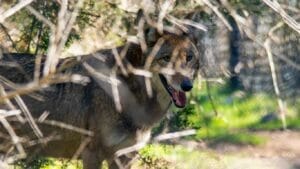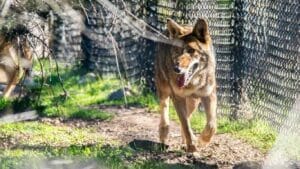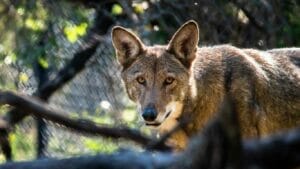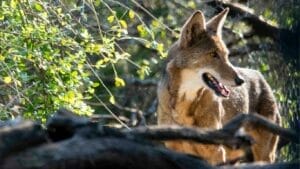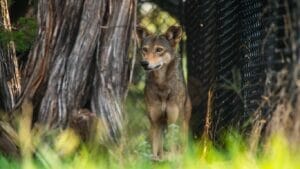
The American Red Wolf was once a common sight across the southeastern United states, but over the years it’s numbers have dwindled down to make it the world’s most endangered canid species. In fact, in 1980 it was declared extinct in the wild, but thanks to careful breeding and reintroduction programs, the American Red Wolf now has a very small wild population in North Carolina. Still, more wolves live in captivity than in their native habitat, and their conservation is an ongoing effort across the United states.
Appearance
Often mistaken for coyotes, American Red Wolves have a brownish-tan coat with ruddy accents on their ears and head. Their muzzles are broad, and their ears are typically tall and pointed. They have slender legs and large feet that help them swiftly navigate their terrain without stumbling. These wolves are known for their shy and secretive personality. They’re mostly active at dawn and dusk, but when they are sighted it will likely be with a small pack of 5 to 8 other wolves that consists of a mated pair and some offspring.
Adaptations
The American Red Wolf is an opportunistic hunter, able to travel around 20 miles a day in search of food. Despite this, they like to stick to their own territory and will go out of their way to avoid humans wherever possible. Their tan coloring helps them to blend in with the prairie grass of their native southeastern habitat, and aids in their stealth.
Conservation
The American Red Wolf has lost more of its historical range than any other large carnivore, at 99.7% loss. This has contributed heavily to the decline of its population, which has seen very little comeback naturally in the wild. However, there are over 200 red wolves living in captive facilities across the U.S, each of whom play an important role in conservation. Fossil Rim was a part of the Red Wolf Species Survival Plan (SSP) from 1989 to 2023. In 2023, the SSP was dissolved and the focus was put on the Saving Species From Extinction (SAFE) program. We are proud to have produced a good number of pups over the years.
Where are they?
Our red wolves live in the Intensive Management Area behind the scenes.
VIEWING TIPS
Red wolves are very shy, so keeping your voice low and stepping lightly can increase your chances of spotting one.
Quick Facts
Scientific Name | Canis rufus |
Species Survival Plan | No |
Habitat | Forests |
Food | White-tailed deer, raccoons, rabbits, rodents and nutria |
Originally Native To | Southeast U.S. |
Characteristics | Intermediate in size between gray wolves and coyotes; coat color is typically brown with red and black accents along the legs, head and ears |
Lifespan | Wild 7 - 10 years |
Social Behavior | Packs of 5 - 8 wolves made up of an alpha pair and offspring of different ages |



